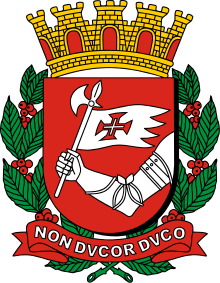Line 6 (São Paulo Metro)
| São Paulo Metro Line 6 (Orange) | ||||||||||||||||||||||||||||||||||||||||||||||||||||||||||||||||||||||||||||||||||||||||||||||
|---|---|---|---|---|---|---|---|---|---|---|---|---|---|---|---|---|---|---|---|---|---|---|---|---|---|---|---|---|---|---|---|---|---|---|---|---|---|---|---|---|---|---|---|---|---|---|---|---|---|---|---|---|---|---|---|---|---|---|---|---|---|---|---|---|---|---|---|---|---|---|---|---|---|---|---|---|---|---|---|---|---|---|---|---|---|---|---|---|---|---|---|---|---|---|
|
| ||||||||||||||||||||||||||||||||||||||||||||||||||||||||||||||||||||||||||||||||||||||||||||||
| Overview | ||||||||||||||||||||||||||||||||||||||||||||||||||||||||||||||||||||||||||||||||||||||||||||||
| Type | Rapid transit | |||||||||||||||||||||||||||||||||||||||||||||||||||||||||||||||||||||||||||||||||||||||||||||
| System | São Paulo Metro | |||||||||||||||||||||||||||||||||||||||||||||||||||||||||||||||||||||||||||||||||||||||||||||
| Status | In planning | |||||||||||||||||||||||||||||||||||||||||||||||||||||||||||||||||||||||||||||||||||||||||||||
| Locale | São Paulo, Brazil | |||||||||||||||||||||||||||||||||||||||||||||||||||||||||||||||||||||||||||||||||||||||||||||
| Termini |
Brasilândia [1] São Joaquim [1] | |||||||||||||||||||||||||||||||||||||||||||||||||||||||||||||||||||||||||||||||||||||||||||||
| Stations | 15 [2] | |||||||||||||||||||||||||||||||||||||||||||||||||||||||||||||||||||||||||||||||||||||||||||||
| Daily ridership | 633,000 (estimated) [1] | |||||||||||||||||||||||||||||||||||||||||||||||||||||||||||||||||||||||||||||||||||||||||||||
| Operation | ||||||||||||||||||||||||||||||||||||||||||||||||||||||||||||||||||||||||||||||||||||||||||||||
| Opened | 2018 (estimated) [1] | |||||||||||||||||||||||||||||||||||||||||||||||||||||||||||||||||||||||||||||||||||||||||||||
| Owner | Companhia do Metropolitano de São Paulo | |||||||||||||||||||||||||||||||||||||||||||||||||||||||||||||||||||||||||||||||||||||||||||||
| Operator(s) | Consórcio Move São Paulo [1] | |||||||||||||||||||||||||||||||||||||||||||||||||||||||||||||||||||||||||||||||||||||||||||||
| Technical | ||||||||||||||||||||||||||||||||||||||||||||||||||||||||||||||||||||||||||||||||||||||||||||||
| Line length | 15.9 km (9.9 mi) | |||||||||||||||||||||||||||||||||||||||||||||||||||||||||||||||||||||||||||||||||||||||||||||
| Track gauge | 1,600 mm (5 ft 3 in)[3] | |||||||||||||||||||||||||||||||||||||||||||||||||||||||||||||||||||||||||||||||||||||||||||||
| ||||||||||||||||||||||||||||||||||||||||||||||||||||||||||||||||||||||||||||||||||||||||||||||
Line 6 (Orange) is a planned extension of the São Paulo Metro. When complete, it will be 15.9-kilometre (9.9 mi) long, with 15 stations,[1] and will link the São Joaquim metro station (Line 1 (Blue)) to the district of Brasilândia.[4] The branch is known as the "Colleges' line" as it will serve many of them along its route (FAAP, PUC-SP and Mackenzie University).[1]
History
This new line will connect with Line 7 (Ruby) and Line 8 (Diamond) of Companhia Paulista de Trens Metropolitanos (CPTM) and lines Line 1 (Blue), Line 2 (Green) and Line 4 (Yellow) of the metro, linking the Northwest, West, Central, and Southeast regions of São Paulo.,[5] totaling 18.4 km in length with 17 stations.[6] The anticipated demand for this line is 600 thousand passengers per day.[7] In 2008 it was predicted that the works would start by 2010, expected to start partial operations in 2012 and full operation by early 2015,[6] but two years later it was expected that the project plans would be finalized only in 2011, with the first stations opening between 2013 and 2014 or as late as 2016, according to some engineers of the Metro.[4]
On March 25, 2008, the State Governor and the mayor of São Paulo pledged to deliver the new metro line by 2012.[8] The municipal government gave the State R$75 million to fund the preliminary designs for the construction of this line.[9][10] In principle, the operation of the line will be the responsibility of the Metro, but there is still the possibility of creating a Public-Private Partnership,[11] which was eventually confirmed.[1]
Currently, the extension of the line between Freguesia do Ó and the São Joaquim is confirmed, providing linkage to Line 1 (Blue) . In a future project, the plan is to extend it to Vila Prudente.
At the other end of the line, Governor José Serra announced on December 4, 2008 that there would be two branches leaving Freguesia do Ó toward the periphery of the North Zone, one in Brasilândia beside a bus terminal that is under study by the city, and another in Vila Nova Cachoeirinha in Largo Japonês, next to an existing bus terminal.[6] It will be the first time that the São Paulo Metro will use a "Y " path, something that already exists in the USA, Europe, Australia[6] and also in other metro systems in Brazil, such as the Brasília Metro. The planning director for Metro, Mark Kassab, explained that there will be a need to change trains at Freguesia do Ó station, because trains will alternate with different destinations across the line.[6]
The functional design of the line was released in June 2010 and referred to the expropriation of 350 commercial and residential properties along the line, including the headquarters of samba school Vai-Vai in Bela Vista and a unit of supermarkets in Consolação.[4]
An extension from São Joaquim 12 stations to Ciudade Lider is planned.
References
- 1 2 3 4 5 6 7 8 do Valle, Caio (December 19, 2013). "Linha das faculdades será aberta em 2018" [Colleges' line will open in 2018]. O Estado de S. Paulo. p. A18.
- ↑ "SP assina contrato para construção da Linha 6-Laranja do Metrô" [São Paulo signs agreement for the construction of Metro Line 6 - Orange]. Secretariat of Metropolitan Transport of São Paulo (in Portuguese). December 18, 2013. Retrieved December 19, 2013.
- ↑ Ferreira, Robert; Tharcisiu Alves. (January 2012). "São Paulo Metro". www.nycsubway.org. www.nycsubway.org. Archived from the original on 2014-02-02. Retrieved 2014-02-02.
On Lines 1, 2 and 3, the track gauge is a non standard 1600 mm, the third rail is 750 V DC and under running. For Lines 4 and 5, the track gauge is 1435 mm and they use overhead pantograph, precluding any connection to the rest of the system, plus the 4 and 5 lines can't connect because the trains on the 4 line use drive-less technology while trains on 5 line are OPTO. Lines 7, 8, 9, 10, 11 and 12 (operated by CPTM) are all 1600 mm and use overhead pantograph.
- 1 2 3 Rodrigo Brancatelli e Eduardo Reina (10 June 2010). S.A. O Estado de S. Paulo, ed. "Linha 6 vai derrubar até 350 imóveis". Jornal da Tarde (in Portuguese). São Paulo (14537): 3A. ISSN 1516-294X. Retrieved 2010-06-19.
- ↑ Official Site
- 1 2 3 4 5 "Linha 6 do Metrô terá ramal até Brasilândia", Daniel Gonzales, Jornal da Tarde, 5/12/2008, pág. 5A
- ↑ "Line 6 will arrive in New towns Cachoeirinha and Brasilândia ",Government Portal of the State of Sao Paulo,4/12/2008
- ↑ "Linha da Freguesia do Ó recebe R$ 75 milhões", Daniel Gonzales, Jornal da Tarde, 27/5/2008, pg. 4A
- ↑ "Serra promete iniciar Linha 6 do Metrô em sua gestão",O Estado de S. Paulo, March 25, 2008
- ↑ "Serra promete iniciar Linha 6 do metrô em sua gestão; obra será entregue em 2012",Uol Notícias, March 25, 2008
- ↑ "Metrô vai ganhar Linha 6 em 2012", Daniel Gonzales, Jornal da Tarde, 26/3/2008, pg. 4A
